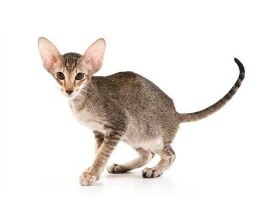
History
The Oriental is best described as a color remake of the original “black and white” Siamese. The breed was developed using Siamese as the foundation breed and then crossing them with other breeds. The original intent was to broaden the Siamese gene pool in Britain because so many breeding programs had been devastated during World War II. Crosses with Russian Blues, British Shorthairs, Abyssinians and domestic shorthairs produced kittens without the pointed Siamese pattern, which were then bred back to Siamese. In just a few generations, breeders produced cats that looked exactly like Siamese, except for the variety of colors and patterns they displayed, as well as cats with the traditional pointed pattern. Cats with Siamese points were used in Siamese breeding programs, but the non-pointed cats became the basis for a new breed: the Oriental. When the cats began to be imported into the United States in the 1970s, crosses with American Shorthairs produced yet more colors and patterns. A longhaired variety was also developed. Today Orientals come in more than 300 colors and patterns, including pointed varieties
Description
The Oriental is a medium-sized cat, beautifully balanced, with head, ears and neck carried on a long, svelte, well-muscled body, supported on slender legs, with feet and tail in proportion. The head and profile should be wedge-shaped, neither round nor pointed. The expression is alert and intelligent.
Grooming and Physical Needs
Size: Petite
- Grooming Needs: short, fine coat of the Oriental Shorthair is easily cared for. Comb it every couple of weeks with a stainless steel comb or soft bristle brush to remove dead hair, then polish it with a soft cloth to make it shine
- Coat Type: Semi longhaired cat
- Moulting: Low
- Exercise Needs: highly intelligent, agile and athletic, and loves to play
- Average Life Span: 10 to 15 years
- Healthcare:
Behaviour
- Family: Extremely fond of their people. They like to be “helpful” and will follow you around and supervise your every move.
- Temperament: Active and social Oriental
- Trainability: Keep his busy brain active with puzzle toys and his body exercised with teaser toys that he can chase and a big cat tree he can climb.
- Sociability (Other Pets): Perfect choice for families with children and cat-friendly dogs
- Meowing: Talkative and opinionated. He will tell you exactly what he thinks, in a loud, raspy voice, and he expects you to pay attention and act on his advice
